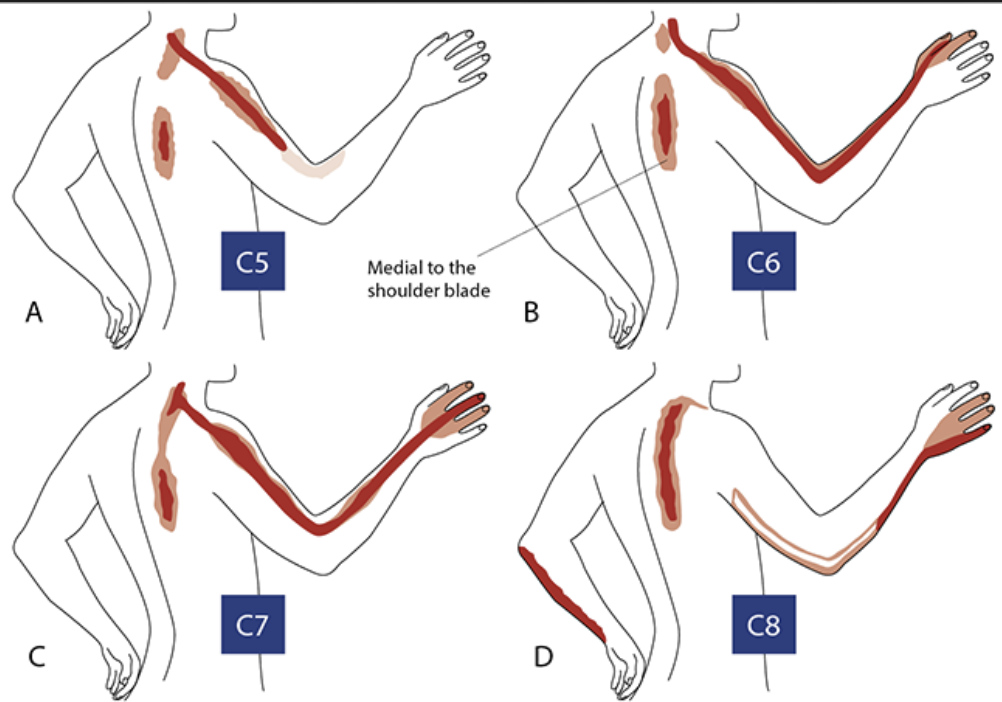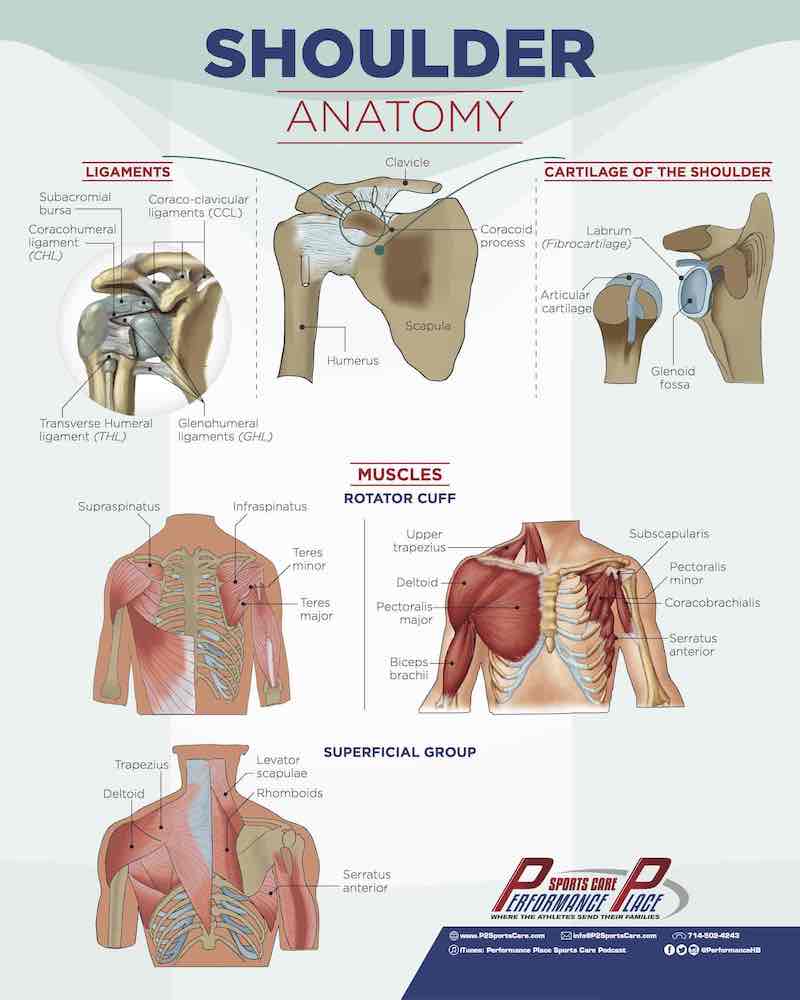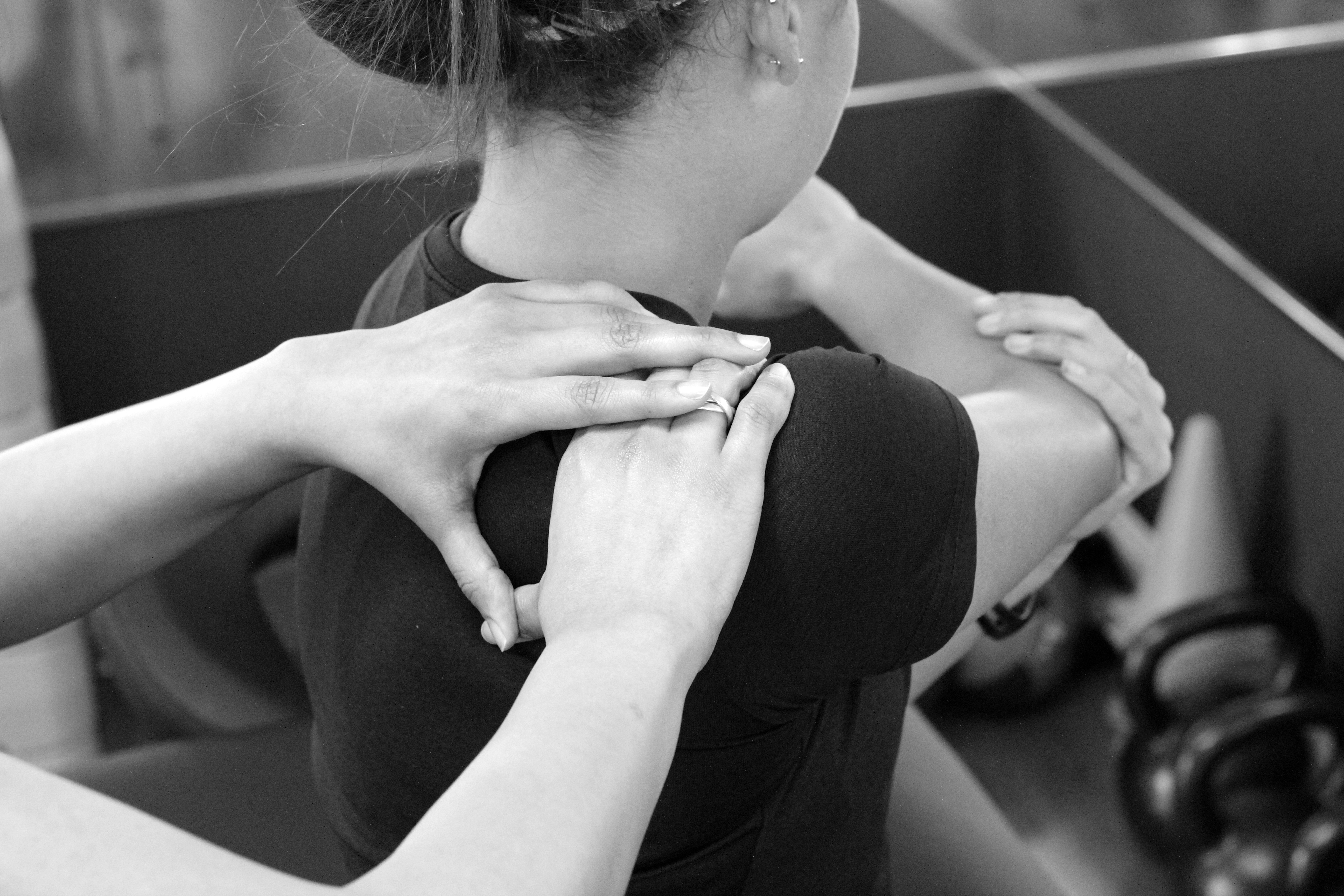This guide will help you learn about SICK scapula in record time.
The best part?
The information in this article about SICK scapula is up to date for 2021.
A lot has changed in the last year but you don’t need to worry about dated information here!
Note: read the disclaimer and always see a doctor first. If you need some help virtually (or in-person) the “Locally World Famous Chiropractors®” at Performance Place Sports Care are ready to work with you!
So without further ado, let’s get started…
SICK Scapula: An Overlooked Cause of Shoulder Pain
Scapula Pain?
Shoulder blade pain (aka scapula pain) most common causes are a muscle strain, referred pain from a cervical nerve root or dorsal scapular nerve. Characterised as a dull ache, burning, stabbing pain in the shoulder blade region or even a “dropped shoulder.” It is treatable, with recovery ranging from weeks to months.
SICK scapula or shoulder dykinesis is a form of shoulder pain created by disorganized movement of the shoulder joint.
Kinesis refers to “motion”, and the prefix “dys” describes something that is “bad, abnormal or difficult”.
In the case of SICK scapula, athletes who repetitively use their arms for overhead motion such as throwing, swimming or swinging a racquet, are all at risk of developing this condition.
Pain may be followed by limited range of motion, and if left untreated, may develop into a more severe shoulder injury.
This article will help explain the anatomy of the shoulder, the features of SICK scapula and the treatments that can be used to correct it.
If you’re interested in what exercises are useful in SICK scapula recovery, I’ve created a mini-guide I call “An Introduction Into The 9 Best Effective Corrective Exercises For SICK Scapula.” It’s on sale this month, so get it while it’s still affordable!
Before you get too deep into the idea that you have SICK scapula, take a look at the symptom chart below. Shoulder blade pain in theses patterns are being mis-diagnosed as SICK scapula.
Theses symptoms are what know as referred patterns. They’re created by minor nerve pressure in the neck.
No, you’re neck doesn’t even need to hurt during the pinching. Minor tightness that you may think is “normal” is very common.
Normal necks should not be tight all the time… stressed or not.
It’s very easy to treat, yet a treatment plan for SICK scapula would be a step in the wrong direction.

To be clear, the plan of attack is different. Other symptoms found in this condition are also very much like SICK Scapula, which is why it’s mis-diagnosed and mis-treated so frequently.
I’d venture to say a strong majority of the “challenging SICK Scapula” cases are really just this… treated with the wrong plan.
– Scapular winging
– Shoulder blade pain/ deep ache
– Neck/ upper trap tightness (minor or major)
– Shoulder pain
– Numbness to the arm or hand (some cases)
If this interests you, please read this article I wrote about it that will help guide you on your journey. I included some tips within.
EXPECTATIONS WHEN YOU
COME SEE US IN COSTA MESA:
MORE THAN 50% IMPROVEMENT WITHIN 4-6 SESSIONS
Most Cases
MORE RELIEF WITH LESS RISK
We Only Use High Reward/Low Risk Treatments
NO RIDICULOUS LONG-TERM TREATMENT PLANS
MORE ATTENTION WITH A SKILLED GUIDE
Even Though our Costa Mesa Chiropractor are Not A "Real Doctor" 🙂
MORE THAN A TYPICAL COSTA MESA CHIROPRACTOR
No Bone Cracking Required To Feel Good
NO QUACKERY
Dr. Gonzales & Costantino Only Uses Current Evidence-Informed Methods
CLICK HERE TO BOOK YOUR APPOINTMENT WITH A COSTA MESA CHIROPRACTOR
I’ll also be giving a few exercises corrections I like to start people with towards the end of the article. You can jump to it here if you don’t want to hear about anatomy and logic about scapula injuries.

Why is it Called SICK Scapula?
SICK is an acronym for the prominent features of the condition:
• Scapular malposition
• Inferior medial border prominence
• Coracoid pain and malposition
• DysKinesis of scapular motion

The Anatomy of the Shoulder
The scapula, more commonly referred to as the shoulder blade, is the boney structure on the upper back below the top of your shoulder and just behind the axilla.
It is a free floating structure with only one attachment to the upper body through a joint located at the end of the clavicle (or collar bone) called the acromioclavicular joint.
The long bone of the upper arm, called the humerus, sits in a small socket on the outer edge of the scapula. It is called the glenohumeral joint.
The glenohumeral joint by itself has very little stability. It relies on a set of four muscles known as the rotator cuff to provide the foundation and stability of the shoulder.
The rotator cuff muscles and their functions are as follows:
• Supraspinatus which predominately stabilizes the shoulder and helps pull the arm toward the body (adduction)
• Infraspinatus which helps rotate the upper arm so the palm faces up (external rotation)
• Teres minor which also aids in external rotation
• Subscapularis which helps elevate the arm away from the body (abduction)

In addition to the rotator cuff, there are several other muscles that are involved in shoulder stabilization and range of motion.
They too can be involved in SICK scapula:
• Trapezius which help pull the scapula toward the spine (scapular retraction), upward as if “shrugging” the shoulders (scapular elevation), and down and inward toward the midback (scapular depression)
• The rhomboids which also aid in scapular retraction
• Levator scapula which also aid in scapular elevation
• Serratus anterior which stabilize the scapula and pull the scapula away from the spine as when the shoulders roll toward the front of the body (protraction/scapular abduction)
• Pectoralis major which helps pull the arm towards the body (adduction)
How SICK Scapula Happens
Because the shoulder is capable of such a wide range of motion, a very complex and harmonious chain reaction of muscle contraction must occur for normal, painless movement.
Usually, this is the case for most of us in our daily lives.
But for those who repetitively use the shoulder in strenuous overhead activity, weakness and instability in any part of that chain reaction can lead to injury.
SICK scapula can be both a precursor to injury or the result of a previous one.
Like the parts of an engine, the muscles of the shoulder must all work together perfectly.
The repetitive overhead use causes certain muscles to weaken while others tighten.
This literally pulls the scapula away from the body, tilting and rotating out of its normal plane of movement. In turn, this puts stress on the head of the humerus as the angle of the glenohumoral joint changes.
Pain and restricted motion of the arm are the result.
Eventually, the normal, smooth movement of the scapula becomes completely distorted due to its altered position. In this state, continued intense, repetitive use greatly increases the chance of severe injury.
Therefore, if there is pain through range of motion or with exertion, it can be important to consider this diagnosis in addition to shoulder strain, as both share common characteristics, but have very different underlying causes.
SICK scapula is a biomechanics problem, while shoulder strains are muscle damage due to intense, repetitive movements that apply too much pressure to the muscle and joint.
Athletes such as swimmers, tennis players, baseball and softball players are susceptible given the nature of their sports.
SICK Scapula Symptoms & Evaluation
Pain and limitation of shoulder movement are usually the main complaints.
Because the scapula is misaligned, the affected shoulder will appear lower than the other or “dropped”. Also, the scapula will appear “winged” or protracted due to its altered position.
The top, front or outer portion of the shoulder may be painful to the touch.
A functional assessment tests for pain, strength and range of motion. It is very useful in diagnosing this condition. Imaging tests can be used if there is a history of shoulder trauma to rule out any fractures. Imaging can also help identify joint degeneration, bony impingement of the soft tissues and arthritis.
If a muscle strain is suspected, a musculoskeletal ultrasound can be used to evaluate for scar tissue, as this can also be a source of restricted shoulder movement and pain.
Treatment for SICK Scapula
The good news is there are many therapeutic options for treating SICK scapula.
The foundation of any program will most likely include RICE (Rest, Ice, Compression and Elevation) in addition to NSAIDs such as ibuprofen or naproxen. In my personal experience, this should last NO LONGER than 3-5 days.
Physical therapy, physiotherapy or working with an experienced strength and conditioning coach are all great options. The addition of specific corrective exercises to assist in strengthening the shoulder blade muscles are critical in long term recovery. If you don’t know where to start, here’s a very affordable and effective guide into corrective exercise and cueing of movement patterns for SICK Scapula recovery.
Soft tissue manual therapy is extremely helpful in reducing the high tension in the pectoralis muscles, upper trap and levator scapula. These practitioners may also recommend or incorporate soft tissue manipulation techniques such as Active Release Technique or Graston Technique.

An important part of any rehabilitation program is stretching. Many athletes fail to recognize the importance of stretching and warming up prior to activity. The presence of scar tissue in the muscle makes it more dense, less flexible and difficult to fully elongate.
Stretching helps get the most out of any strengthening regimen.
The common misconception that a tight muscle is a strong one is not only incorrect- it can lead to injury!
Sometimes, a tight muscle signifies it is weak, in constant spasm to maintain function, and on the verge of greater injury.
In SICK scapula, the pectoralis minor is usually very tight, contributing to the misalignment of the scapula. An effective stretch for this muscle is simply placing the forearm flat on a wall or doorway and then stepping forward. Stretches such as this should be incorporated into the therapeutic routine.
Eccentric rehabilitative exercises are also very helpful as they focus on strengthening the muscles and tendons involved in SICK scapula. These exercises can stimulate healing within the first six weeks, giving the best prognosis for recovery. Approximately 8-12 weeks of treatment will be needed, depending on the injury.
Steroid injections may be of use in decreasing the discomfort and in some cases, surgery is indicated in order to repair torn muscular tendons.
In summary, it is important to consider SICK scapula when there is shoulder pain. It is a diagnosis that can easily be made in certain athletes who perform overhead activities and have very specific findings on a physical exam.
Most importantly, when recognized early and treated, it can spare further advanced injury.
Looking for assistance with your shoulder condition? We do offer online courses for education of the area, rehab exercises and empowerment to know you have control over your condition.
SICK Scapula Therapy Exercises
I commonly see people frustrated about the progress of their scapula injury. They’re normally given the basic stretches and exercises. I’ll name a few:
- Doorway Stretch for the Pectoralis minor
- Wall Angels
- Foam rolling or self massage of the Pec Major and Upper Trap
- Ice/ Heat
- T, Y, W (face down exercises that nobody can name)
These are the most common and I personally don’t see anything wrong with them but they don’t account for the foundational structures/ regions of the shoulder blade.
Often we have to check a few things first. These are the regions I check before I give any shoulder blade specific exercises.
- The Core & Breathing pattern to allow for a rigid trunk
- Midback and Neck Motion Quality
If you don’t understand this you need to listen to my iTunes Podcast Session 47 with Max Shank. You’ll be blown away.
Here’s an exercise I use to warm people up through the shoulder blade… truthfully, if you don’t “press the ground away” the entire time, yes your shoulder will hurt but if you do it right, you will feel light years better. The stronger of a “post” you make the arm (and leg) the less they will hurt and more stable the shoulder blade will become, hence less singed scapula.
Here’s a video series I like to start people on with SICK Scapula. They account for the parts mentions above and are also more productive for the time we have in our day than the first list I gave.
If you have a short attention span you better get some popcorn. Some of these videos can be pretty detailed but they require full understanding and often in-person cueing to get right.
Think about it, you got like this through moving your body how YOU thought was correct. Often it just takes someone like me to bring your attention to the corrections and then you’re on your way.
In summary, it is important to consider SICK scapula when there is shoulder pain. It is a diagnosis that can easily be made in certain athletes who perform overhead activities and have very specific findings on a physical exam.
Most importantly, when recognized early and treated, it can spare further advanced injury.
Looking for assistance with your shoulder condition? We do offer online courses for education of the area, rehab exercises and empowerment to know you have control over your condition.
What is Scapula Dyskinesis?
Scapula Dyskinesis (also called SICK Scapula Syndrome) is an abnormal position of the shoulder blade at rest or with active movements of the shoulder.
What causes Scapular Dyskinesis?
Scapular Dyskinesis is caused by muscular imbalances, glenohumeral (shoulder) joint pathology, or neurological compromise. The most common cause is an abnormal function of the long thoracic nerve. Abnormal function leads to muscular imbalances, winging scapular appearance, and local muscle pain.
What muscles are weak in scapular winging?
The serratus anterior muscle is often weak in a winged scapula presentation. Without a serratus anterior muscle, you would not be able to raise your arm over your head. Other muscles that are often weak are the middle and lower trapezius muscles, as they are more active in overhead activity.
How do I improve my scapular upward rotation?
A customized exercise plan is vital. Activities that improve thoracic extension and rotation are required as precursors to shoulder blade stability exercises. Exercises to create scapular stability should include ones that challenge the serratus anterior muscle, middle, and lower trapezius muscles.
How do you improve scapular depression?
Common sense would say improve your posture, but this can get exhausting and lack lasting results. Try a midback mobility exercise instead. A rounded upper back forces the upper trapezius and levator scapula muscle to pull upward on your shoulder blade. Mobilizing the midback throughout the day can help set the stage so gravity can depression your scapula for you.

